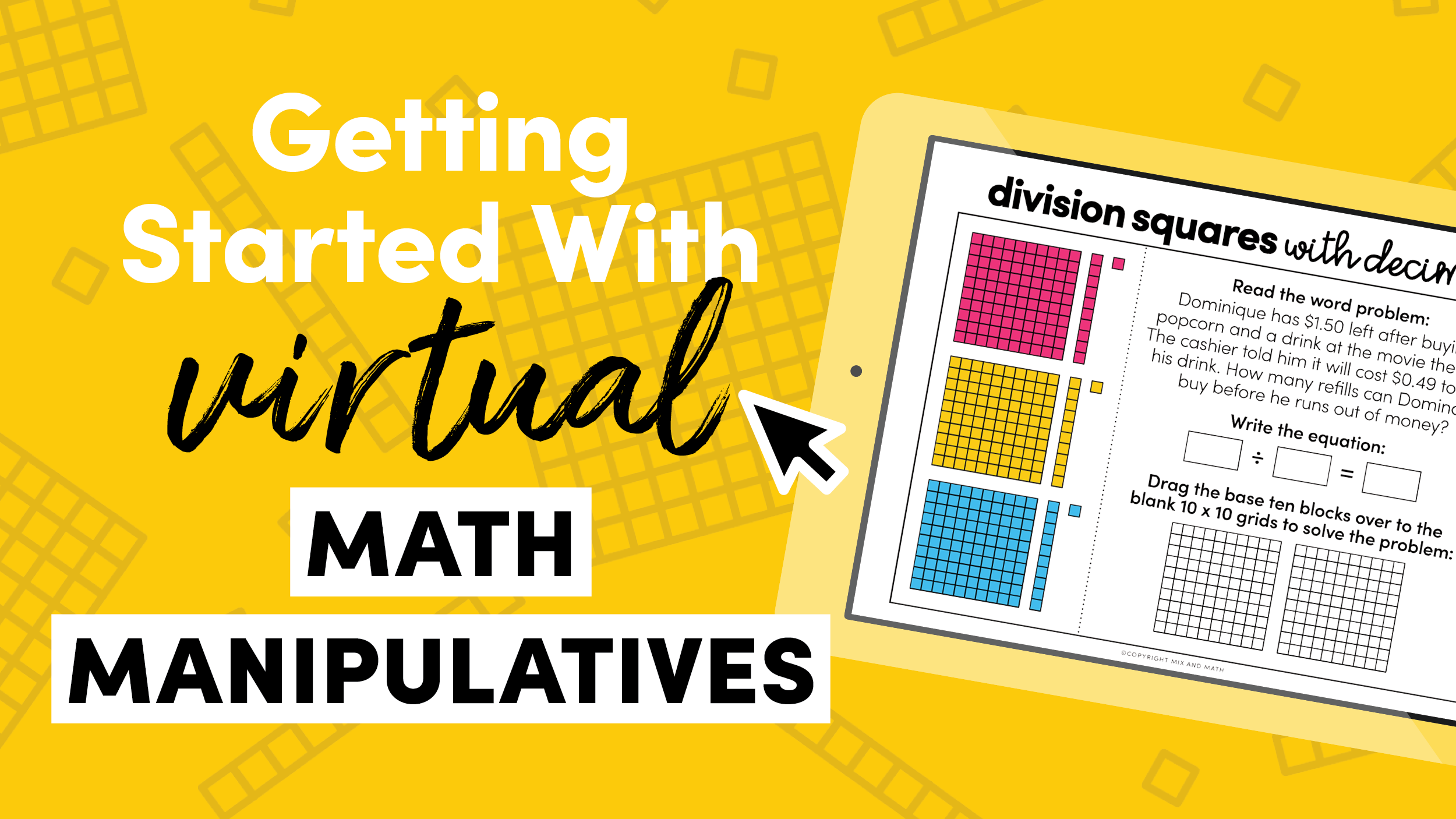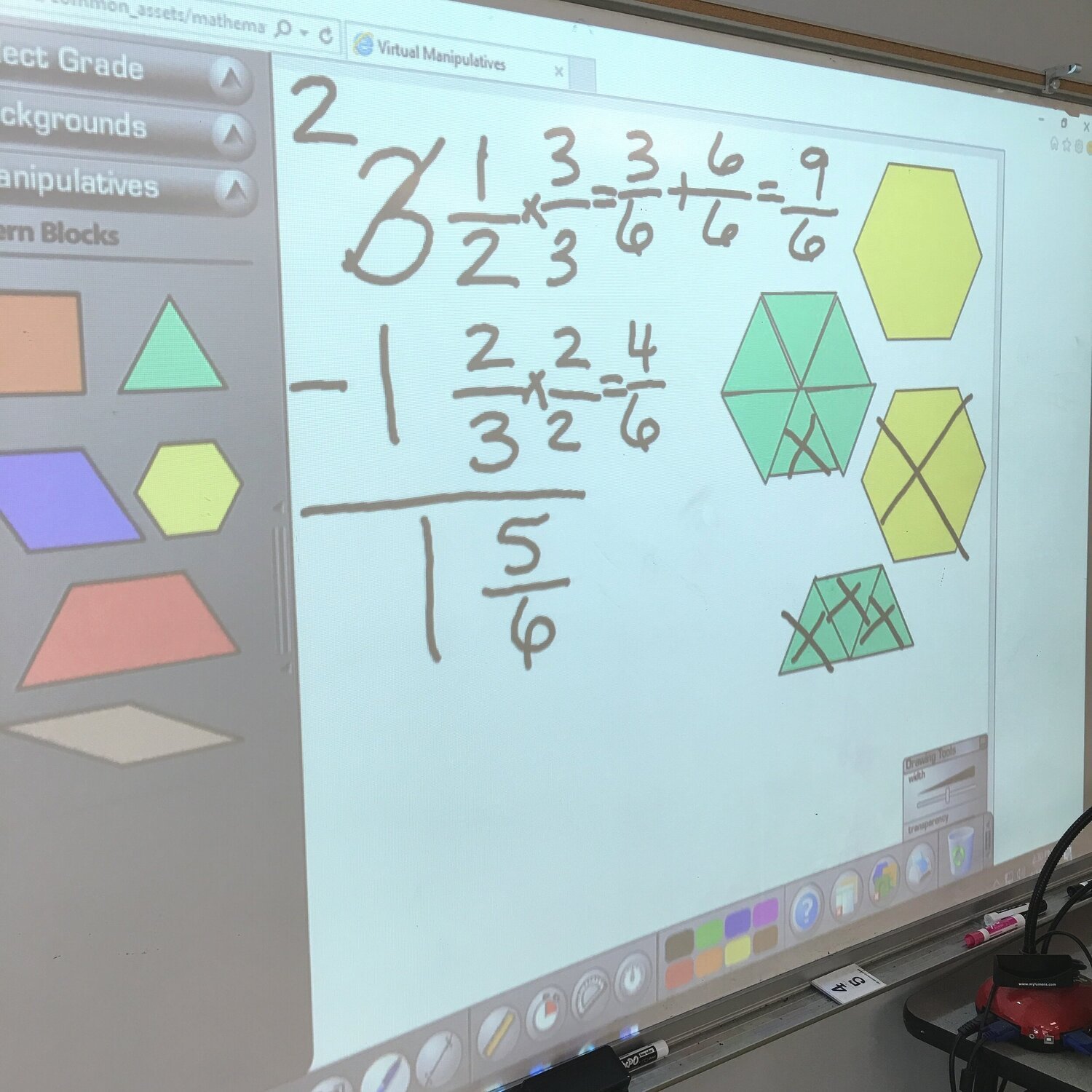Getting Started with Virtual Math Manipulatives
In all honesty, I haven’t always been the biggest fan of virtual math manipulatives. I used them every once in a while early in my teaching career, but I usually gravitated towards my physical math manipulatives. I truly believe there is SO much power in exploring math concepts with your hands and brain simultaneously.
But just because working with physical manipulatives may be my preference for students, doesn’t mean that virtual manipulatives can’t play an important role in our classrooms too! Depending on your classroom circumstances and learning goals, I think there are a lot of benefits to working with manipulatives digitally.
Here are five reasons why virtual math manipulatives should really be a part of every math classroom (when technology is available, of course).
Access to a Library of Manipulatives
One benefit of virtual math manipulatives is that you have access to all sorts of math manipulatives even if the number of physical manipulatives you have in the classroom is limited. Do you have a hand-me-down stash of fraction tiles and the only way to make a complete set is to steal pieces from two other sets? The beauty of digital manipulatives is you never have to worry about missing pieces or having enough sets! Virtual manipulatives come with all the sets your math heart desires!
Most virtual manipulative libraries have a wide variety of manipulatives available. The manipulatives I used most frequently in the classroom can all be found online! So while you may be working on slowly growing your own library of physical math manipulatives (because goodness, they are NOT cheap!), virtual manipulatives can help you fill in some gaps in the mean time.
Quick and Easy Clean Up
While I don’t believe math manipulatives have to be a management buster if you have good systems in place in your classroom, the fact of the matter is that virtual math manipulatives are much easier to “pass out,” clean up, or move between centers even with the best routines in place.
The ease of access just makes it easier to bring manipulatives out on the fly. Whether you’re working with a group of students who repeatedly demonstrate a misconception about regrouping or you’re walking around the room when you notice a student who may need to revisit the concrete phase of adding mixed numbers, it takes no time at all to have these students grab their devices and open up a digital manipulative app.
Modeling Math Concepts to the Class
Virtual math manipulatives are fantastic when you need to model something for the whole class or a larger group of students. While you can always throw some physical manipulatives under a document camera (which I frequently did before I started using digital manipulatives), being able to display the manipulatives on a whiteboard is a game changer!
I loved being able to write on the manipulatives when I was reinforcing a connection between the concrete (manipulatives) and abstract (algorithm). In fact, I think the image below was a student showing this connection for a group of students to see!
Giving Students Variety
This benefit is coming to you strictly from an engagement standpoint. Virtual math manipulatives are just really great when you want to switch things up! I find during our fractions unit that we spent a LOT of time with pattern blocks. Some days we would use virtual pattern blocks just to give students some variety.
There’s nothing wrong with recognizing your students need a bit of a change and virtual math manipulatives make that possible! For some students, the excitement of using technology to show their thinking increases their motivation and focus!
Recording Students’ Thinking
This might be one of the biggest benefits to using digital math manipulatives in your math class. When students work with physical manipulatives, their thinking is often “erased” when they tidy up their work space and move on to the next problem (unless you have students record their thinking on paper which students may or may not be able/ready to do).
With virtual manipulatives, there are several options for recording students’ thinking so that you can assess where a student is at conceptually even when you aren’t sitting right next to them to watch them work with manipulatives and explain their thinking. One option is to have students take a screenshot of their work and submit it along with an explanation of what they were modeling and how their model represents the math. Another option is to use a program like Loom (which is free!) where students can record their screen as they model the math and talk through why they are doing what they are doing. The recording will include both their screen and voice.
Online Math Manipulative Recommendations
Now that you know some of the benefits, you may be wondering where you can find the best digital math manipulatives. There are so many options when it comes to virtual math manipulatives (which is a great problem to have since this hasn’t always been the case!). While most options are relatively the same, some options provide “extras” that are really helpful.
I’ve narrowed it down to my two favorites that are accessible and functional on the most popular devices found in classrooms. Both of these options can be used on Chromebooks, Apple products, desktop computers, and interactive whiteboards. They also both have the option to write on the manipulatives and/or the board, which I really appreciate as I think it is so important to make those connections between concrete and written methods.
Math Learning Center
If you’re looking for a reliable website with virtual math manipulatives, Math Learning Center has got you covered! This is what I used most frequently when I first began using virtual math manipulatives in the classroom. Students can use the manipulatives using their website or they can download the app. This is a really solid option and one of the best available!
By the way, they have a new Partial Products Finder app that I absolutely love! It is definitely worth checking out!
BrainingCamp
Goodness, I just love BrainingCamp. It is such a clean platform and there are little added features that the creators included that I really appreciate. The added features are specific to each manipulative, so I won’t go into detail about each one. They do have videos for how to use each manipulative with different math concepts if you are just starting out with manipulatives!
While you can get a 30-day free trial, this is a paid option. If you’re interested in purchasing access to BrainingCamp, I’d highly recommend asking your administrator to buy it for you and your students. It is relatively inexpensive as far as educational technology platforms go and it is very easy for students to login and access the manipulatives. If you do the trial, you will fall in love with it! (It’s the platform I was using in the video below.)
Planning Instruction with Both Types of Manipulatives
Many of the benefits I mentioned above can be accomplished with physical manipulatives too. At the end of the day, both physical and virtual math manipulatives are tools to help students explore and represent math concepts. While I will never, ever give up my physical manipulatives, I think both types of manipulatives can work together to create meaningful learning experiences for students!
If you’re looking for ideas on what to actually do with the virtual math manipulatives in your classroom, check out this Facebook Live I did over on the Mix and Math Facebook page. I briefly talked about the benefits of virtual math manipulatives in the first few minutes and then we dug into different activities students could do that are both meaningful and engaging!
If you haven’t ever tried using virtual math manipulatives in your classroom, I hope this gave you a few ideas for how to begin incorporating them into your instruction! I’ve got FREE Digital Math Manipulative Activities you can use if you’re ready to try it out!


